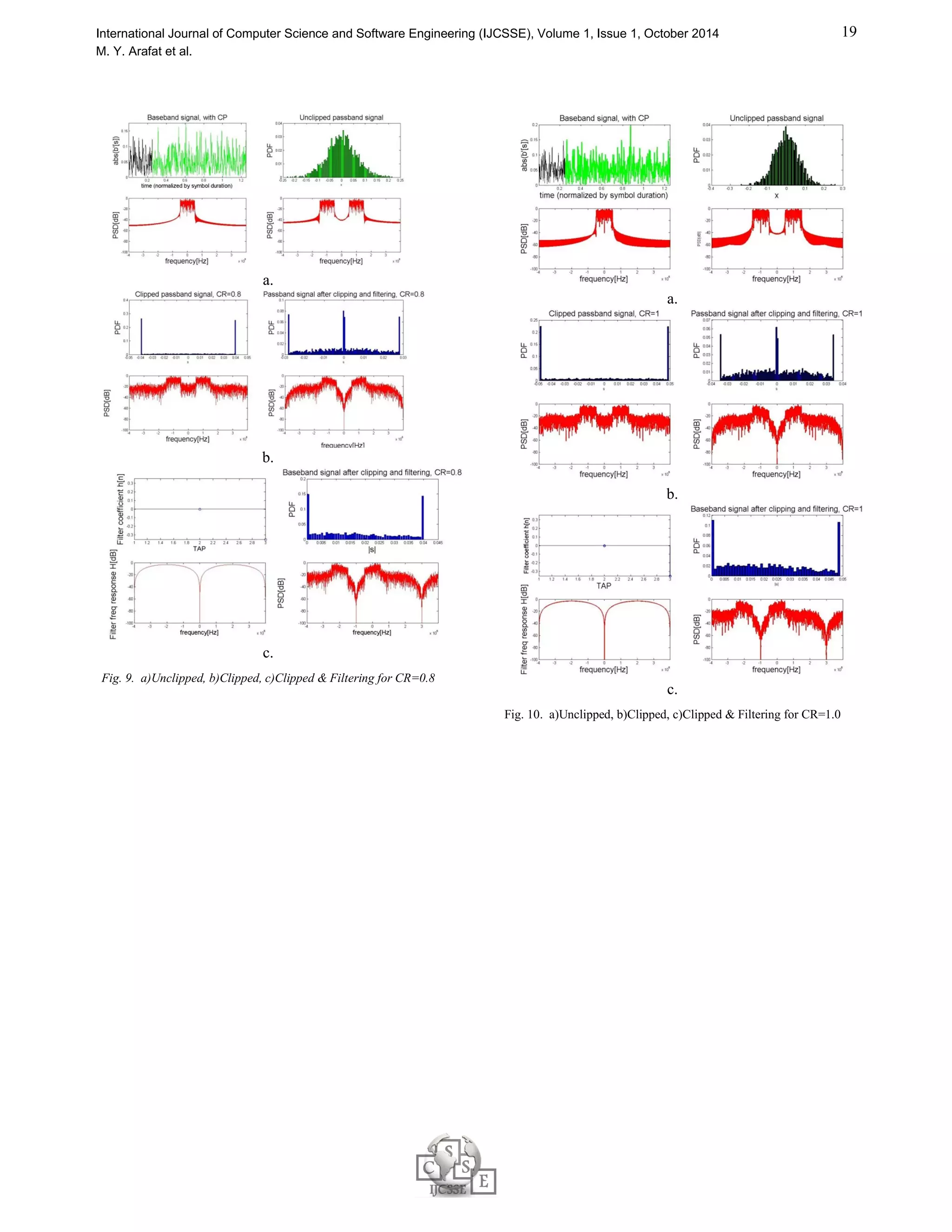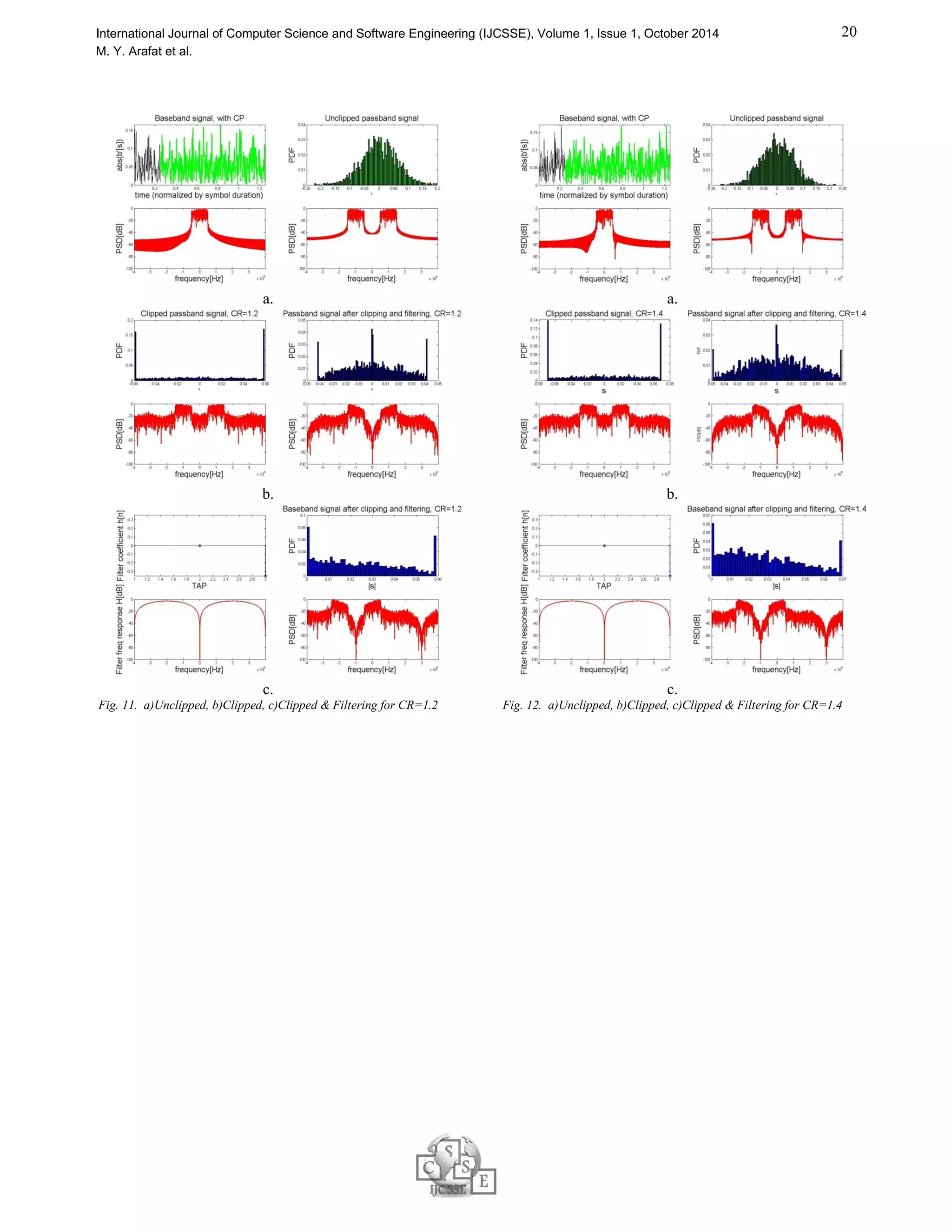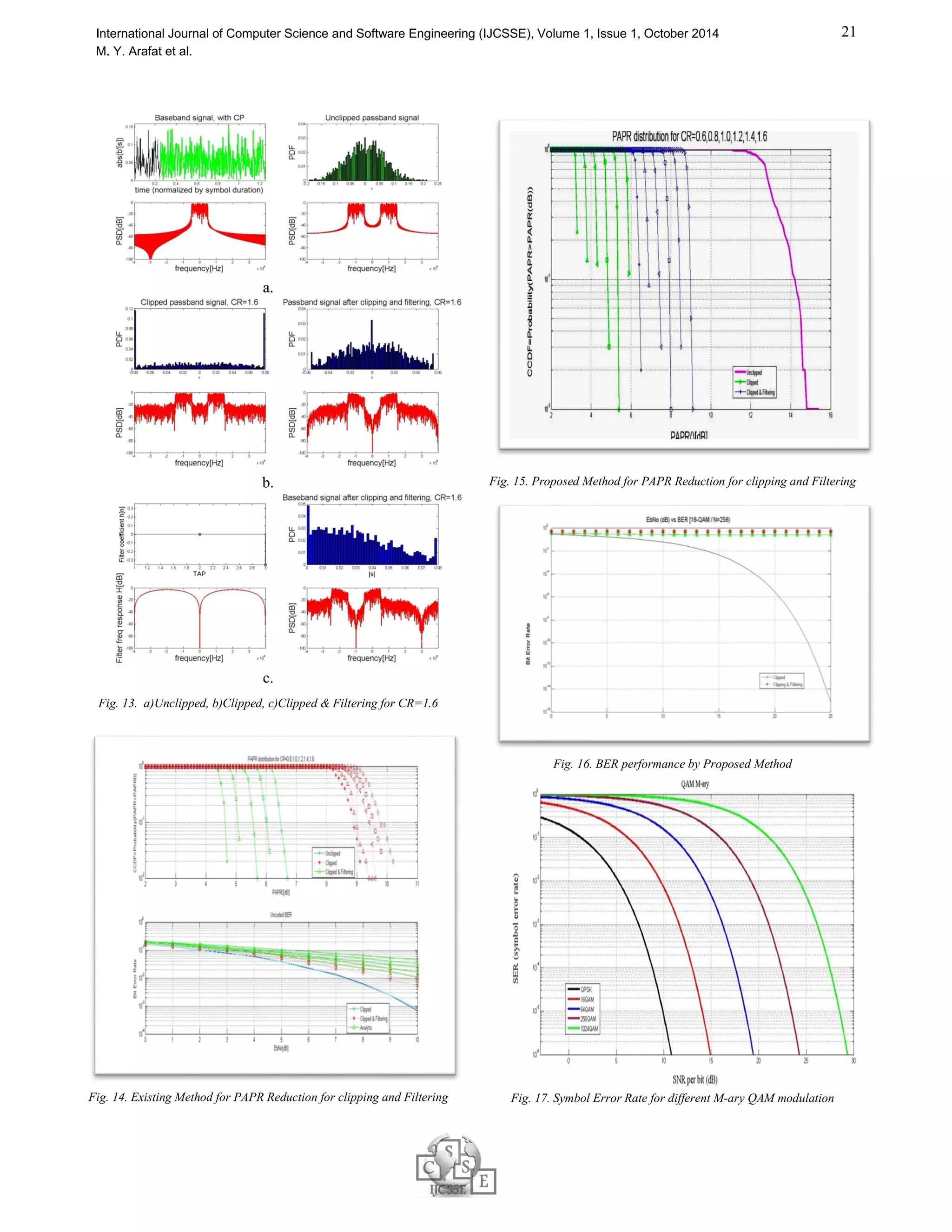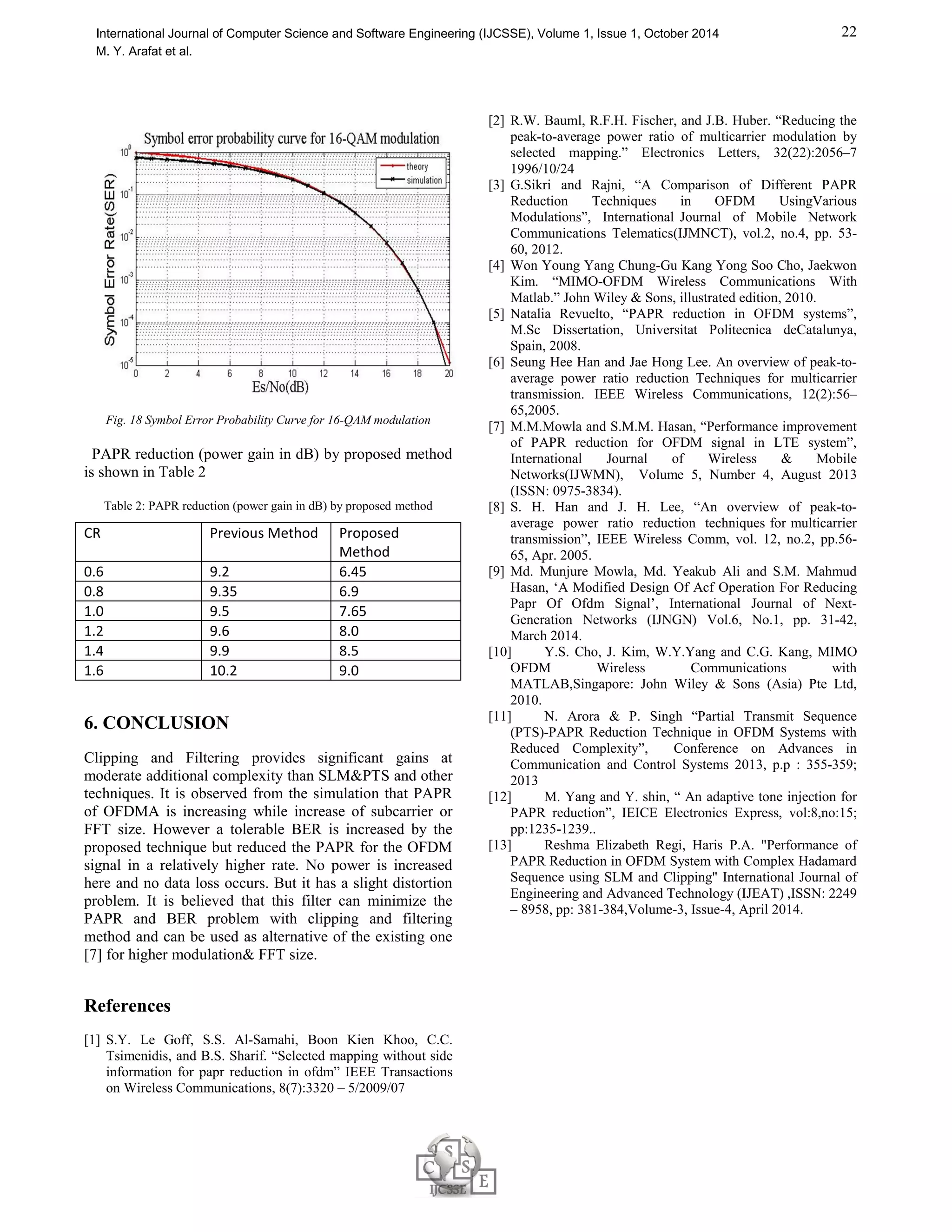This paper presents a performance evaluation of peak to average power ratio (PAPR) reduction techniques for orthogonal frequency division multiplexing (OFDM) in 3GPP LTE downlink systems, focusing on amplitude clipping and filtering methods. The proposed technique, which involves using a composed high pass, low pass, and Chebyshev band pass filter after amplitude clipping, demonstrates significant improvements in symbol error rate (SER) and bit error rate (BER) while reducing PAPR. The results indicate that the proposed method effectively enhances OFDM systems' performance under high capacity and speed mobile communication conditions.
![International Journal of Computer Science and Software Engineering (IJCSSE), Volume 1, Issue 1, October 2014
ISSN (Online): 2409-4285 www.IJCSSE.org Page: 14-22
Performance Evaluation of PAPR Reduction with SER and BER by
Modified Clipping & Filtering in 3GPP LTE Downlink
M. Y. Arafat1, S. Abd. Latif2, M. K. Alam3, S. S. Haque14, M. Akter5
1, 4 Department of ETE, RUET, Rajshahi-6204, Bangladesh
2, 3, 5 Department of Electrical and Computer Engineering, International Islamic University Malaysia,
Kuala Lumpur, Malaysia
1yeasir.ete.ruet09@gmail.com, 2suhaimie@iium.edu.my, 3shishir_lmu@yahoo.com,
4snikdho.ruet.ete.09@gmail.com, 5m.tethi@gmail.com
ABSTRACT
This paper work focuses on performance analysis of PAPR
reduction of orthogonal frequency division multiplexing
(OFDM) using amplitude clipping & filtering based design. Now
a days one of the most proficient multi-carrier transmission
techniques widely used today is orthogonal frequency division
multiplexing (OFDM) which has been implemented by the next
generation wireless communication technology: Long Term
Evolution (LTE). Extra robustness to multipath fading and
impulse noise is provided OFDM. It eliminates inter symbol
interference (ISI) & inter carrier interference (ICI) with certain
procedure. Therefore peak to average power ratio (PAPR) is the
basic problem with OFDM. However in this paper we proposed a
reduction procedure of the PAPR by using clipping and filtering.
Here we use a composed high pass , low pass & Chevyshev band
pass filter II after amplitude clipping to reduce the PAPR. The
performance of the system in terms of bit error rate (BER) and
symbol error rate (SER) is also investigated as a new filter based
clipping method is proposed. Our proposed clipping method with
and composed high pass the Chevyshev bandpass filter II in
PAPR performance of the system with a little compromise of
BER & SER showing the significant improvement in Quadrature
Amplitude Modulation (QAM).
Keywords: OFDM, LTE, Chevyshev, BER, Clipping and
Filtering(CF).
1. INTRODUCTION
One of the latest steps towards the 4th generation (4G) of
radio technologies is Long term evolution (LTE) which
has been designed to increase the capacity and speed of
mobile telephone networks. Data usage & voice
communication has grown fast now days in those networks
where 3GPP High Speed Packet Access (HSPA) was
introduced indicating that the users find using the network
connection like broadband wireless data. 3GPP Long Term
Evolution (LTE) has been designed to provide high data
capacity in data delivery at a comparatively lower cost.
But these services require highly reliable data transmission
over most of the time in very unfriendly environment.
Most of these transmission systems have to face much
degradation such as large noise, multipath, interference,
attenuation, nonlinearities, time variance and must meet
the finite constraints like crest factor & power limitation.
Most commonly used technique in multi-carrier
modulation is Orthogonal Frequency Division
Multiplexing (OFDM) which has become very popular in
wireless communication. But its large envelope fluctuation
which is quantified as Peak to Average Power Ratio
(PAPR) is the major disadvantage of OFDM transmission.
In order to operate in a perfectly linear region, the
operating power must be kept below the available power.
For this reason, power amplifier is used at the transmitter.
A lot of algorithms have been developed for the reduction
of this PAPR. All of them have their own advantages and
disadvantages [2]. Moreover, the data rate is reduced by
the Coding scheme which is undesirable. In case of
applying the Partial Transmit Sequence (PTS)[11] and
Selected Mapping (SLM) techniques, these are more
complex than that of CF technique. If another technique
named Tone Reservation (TR) is considered, it also allows
the data rate loss with more likelihood of increasing power.
As well as the techniques such as Active Constellation
Extension (ACE) and the Tone Injection (TI) [12] having
criteria of increasing power will be unexpected in case of
power constraint environment. The Selected Mapping is
one of the most commonly chosen techniques because of
its simplicity for implementation which bears no distortion
in the transmitted signal. It has been described first in [2]
i.e. to be known as the classical SLM technique which
contains one of the disadvantages like sending the extra
Side Information (SI) index along with the transmitted
OFDM signal. A special technique described in [1] can be
used to avoid this issue. However using complex matrix
sequence [13] doesn’t give the desired PAPR reduction.](https://image.slidesharecdn.com/p3-v1i1-141113080805-conversion-gate02/75/Performance-Evaluation-of-PAPR-Reduction-with-SER-and-BER-by-Modified-Clipping-Filtering-in-3GPP-LTE-Downlink-1-2048.jpg)
![15
International Journal of Computer Science and Software Engineering (IJCSSE), Volume 1, Issue 1, October 2014
M. Y. Arafat et al.
In previous research works, a linear-phase FIR filter using
the Parks-McClellan algorithm was used in the composed
filtering [7]. Existing method [9] uses the band pass filter.
But, using our proposed special type of composed filter,
significant improvement was observed in the case of
PAPR reduction.
The rest of this paper is organized as follows: section 2
deals with basic OFDM technique and PAPR calculation,
Clipping and Filtering technique in section 3, section 4
proposed clipping and filtering technique, in section 4
explains design and simulation and this paper is concluded
with the last part.
2. BASIC OFDM TECHNIQUE AND PAPR
CALCULATION
Orthogonal Frequency Division Multiplexing (OFDM)
technique divides the frequency spectrum into sub-bands
small enough so that the channel effects are constant (flat)
over a given sub-band. After that a classical IQ (In phase
Quadrature phase) modulation QPSK, M-QAM, BPSK,
etc. are sent over the sub-band. If it can be designed
correctly, all the fast changing effects of the channel will
disappear during the transmission of a single symbol and
thus will be treated as flat fading at the receiver. OFDM is
a special form of multicarrier modulation (MCM) with
densely spaced subcarriers with overlapping spectra
allowing multiple-access. A large number of orthogonal
subcarriers are used to carry data which are closely spaced.
For each subcarrier, the data is divided into several parallel
data streams or channels. Each subcarrier is modulated
using a conventional modulation scheme like Phase Shift
Keying (PSK) or Quadrature Amplitude Modulation
(QAM) at a low symbol rate. In this case the total data rate
is to be maintained similar to that of the conventional
single carrier modulation scheme with the same bandwidth.
For achieving high data rate and combating with multipath
fading in Wireless Communications Orthogonal Frequency
Division Multiplexing (OFDM) is a promising technique.
It is a special form of multicarrier modulation which is
particularly suited for transmission over a dispersive
channel. The different carriers are totally independent of
one another which denotes that they are orthogonal to each
other. By placing the carrier exactly at the nulls in the
modulation spectra of each other these orthogonal carriers
can be achieved as shown in the following Figure 1. Each
carrier has an integer number of cycles over a symbol
period denoting the orthogonally of the carriers. The
spectrum of each carrier has a null at the centre frequency
of each of the other carriers in the system due to this
integer number of cycles which results in no interference
between the carriers that allows them to be spaced as close
as possible. The problem of overhead carrier spacing can
be recovered that is required in Frequency Division
Multiplexing (FDM). For bandwidth efficiency [4] this
multicarrier transmission scheme allows the overlapping
of the spectra of subcarriers.
Fig. 1. OFDM Spectrum
As a result of incidence of large number of independently
modulated sub-carriers in an OFDM system, as compared
to the average of the total system, the peak value of the
system may be very high. The coherent summation of N
signals having same phase produces a peak which is N
times the average signal [3]. In the design of both high
power amplifier (HPA) and digital-to-analog (DAC)
converter, PAPR is an vital factor in order to generate
almost error-free (minimum errors) transmitted OFDM
symbols.
In the transmitter, the linear power amplifiers are used in
order to make sure that the Q-point must be in the linear
region. The Q-point moves to the saturation region due to
the high PAPR resulting in the clipping of signal peaks
which generates in-band and out-off band distortion. The
dynamic range of the power amplifier should be increased
to keep the Q-point in the linear region which again
reduces its efficiency and enhances the cost. Hence a
trade-off exists between nonlinearity and efficiency. With
the incensement of this dynamic range, the cost of power
amplifier increases. As communication engineer our
objective undergoes investigating the comparative
performance analysis of different higher order modulation
techniques by using amplitude clipping & filtering based
design (signal distortion) to reduce PAPR.
The ratio between the maximum power & the average
power is defined for the envelope of a baseband complex
signal ̃(t) i.e.[2]
PAPR =](https://image.slidesharecdn.com/p3-v1i1-141113080805-conversion-gate02/75/Performance-Evaluation-of-PAPR-Reduction-with-SER-and-BER-by-Modified-Clipping-Filtering-in-3GPP-LTE-Downlink-2-2048.jpg)

![16
International Journal of Computer Science and Software Engineering (IJCSSE), Volume 1, Issue 1, October 2014
M. Y. Arafat et al.
Fig. 2. Input Output characteristics of an HPA
PAPR{s(t) }= ()
!
= ()
∫
%
|() | $ (4)
Here, Pavg denotes the average power of the complex pass
band signal s(t) in the frequency domain it can be
computed because Inverse Fast Fourier Transform (IFFT)
is a unitary (scaled) transformation. For superior estimated
the PAPR of continuous time OFDM signals, the OFDM
signals samples are obtained by L times oversampling. The
time domain samples which are L times oversampled are
the NL point IFFT of the data block including (L-1)N
zero-padding. As a result, the oversampled IFFT output
can be expressed as the following equation:
X[n] = 1
,-.
/0 1
√ ) ((Σ +
2345
67 ) (5)
3. CLIPPING AND FILTERING
TECHNIQUE
For PAPR reduction in 3GPP LTE downlink system, one
of the easiest techniques which can be followed is
Amplitude Clipping of the signal and after that filtering the
signal. To do limit the peak envelope or amplitude of the
input signal a threshold value of the amplitude is made
fixed here [5].
The CR or clipping ratio is defined as below:
CR=
8 (6)
Here, P denotes the amplitude of the signal and σ denotes
the root mean squared value of the OFDM signal
(unclipped). The clipping function is performed in digital
time domain before the digital to analog (D/A) conversion
and the process is described by the following equation:
9:
=
9 9 ≤
1?∅(A) 9 (7)
where, 9:
is the clipped signal, the transmitted signal is
9, the amplitude and the phase of the transmitted signal,
9 is M and ∅(9) respestively.
4. PROPOSED CLIPPING AND
FILTERING TECHNIQUE
By indicating the second point of limitation [8], less BER
degradation can be obtained and that is clipped signal
passed through the band pass filter (BPF).
Clipped signal would pass through a high pass filter
(HPF) [7] was the phenomenon for the former designed
scheme for clipping filtering method. In the figure 3, the
proposed method is shown.
The input of the IFFT block is the interpolated signal
introducing
Q(Z −1) zeros in the middle of the original signal is
expressed as:
C′[] = FC[] GHI, 0 ≤ L ≤ M
N , OP − M
N L OP
0 , SLℎ1IUV1
(8)
The Z-times oversampled discrete-time signal is generated
in this system as the following equation:
W′[I] = 1
YXPO Σ C′[]1Z[
234Δ]
`M-. ^_
/0 ; r=0,1,…,Q(Z-1) (9)
After that the above over-sampled-discrete time signal gets
modulated with carrier frequency fc, yielding a pass band
signal Be’[r]
Fig. 3. Proposed Clipping and Filtering Block Diagram
[r] is the clipped version of Be’[r] which
Now, assuming W
is expressed as the following equation:
[r]=a
W
− Be′[r] ≤ −M
Be′[r] ⎸Be′[r]⎸
Be′[r] ≥ M
(10)
Here, the pre-specified clipping level is M. The signals are
passed through the proposed Composed Filter after](https://image.slidesharecdn.com/p3-v1i1-141113080805-conversion-gate02/75/Performance-Evaluation-of-PAPR-Reduction-with-SER-and-BER-by-Modified-Clipping-Filtering-in-3GPP-LTE-Downlink-4-2048.jpg)
![17
International Journal of Computer Science and Software Engineering (IJCSSE), Volume 1, Issue 1, October 2014
M. Y. Arafat et al.
clipping. A set of FFT-IFFT operations are performed in
the filter, where after the FFT function the filtering
operation occurs in the frequency domain. The FFT
function transforms the clipped signal, W
[r] into the
[s]. The
frequency domain results in the term C
[s] are then passed through
information components of C
a high pass filter (HPF) generating Wh
[s]. This filtered
Wh
signal is then passed through the unchanged condition of
IFFT block. Here, the out-of-band radiation that fell in the
zeros is set back to zero. The signal is transformed in to
time domain by The IFFT block of the filter and thus
obtain [r]. After a low pass filtering our desired signal
is B’[r](s).
5. DESIGN AND SIMULATION
The observations were actually based on only QAM
modulation. Table 1 shows the values of parameters used
in the simulation for analysing the performance of clipping
and filtering technique. It can be seen from the simulations
results that it is possible for clipping and filtering scheme
to reduce peak to average power ratio (PAPR). Simulation
is done in the QAM modulation scheme i.e. 4-QAM has
been used in OFDM generation which is very effective
modulation techniques in 4G technologies having a
bandwidth conserving modulation technique. The number
of sub-carriers N is randomly having a sampling frequency
of FS= 8 MHz, satisfies the condition of orthogonality.
PAPR(dB) of the original OFDM is computed by
oversampling the number of sub-carriers K by the
oversampling factor of L=8 while L=4 is enough, by
insertion of (L-1) N zeros to reduce the ISI.
Complementary Cumulative Distribution Function
(CCDF) of PAPR is the measure of probability that how
much higher is the PAPR value in comparison to PAPR
(dB) is calculated by Monte-Carlo simulation.
Table 1: Parameter used for simulation
Bandwidth, BW 1 MHz
Over Sampling Factor, Z 8
Sampling Frequency, fs 1 MHz
Carrier Frequency, fc 12 MHz
Cyclic Prefix Size 16
No. of Subcarrier/FFT
256
Size, N
Clipping Ratio 0.6,0.8,1.0,1.2,1.4,1.6
Modulation 16-QAM
It can be seen from the simulations results that it is
possible for clipping and filtering scheme to reduce peak
to average power ratio (PAPR). Simulation is done in the
way, QAM modulation scheme i.e. 16-QAM has been
used in OFDM generation which is very effective
modulation techniques in 4G technologies having a
bandwidth conserving modulation technique. The number
of sub-carriers N is randomly having a sampling frequency
of FS = 8 MHz, satisfies the condition of orthogonality.
PAPR(db) of the original OFDM is computed by
oversampling the number of sub-carriers N by the
oversampling factor of Z=8 while Z=4 is enough, by
insertion of (Z-1) N zeros to reduce the ISI.
Complementary Cumulative Distribution Function
(CCDF) of PAPR is the measure of probability that how
much higher is the PAPR value in comparison to PAPR
(db) is calculated by Monte-Carlo simulation.
Figure 8 shows the existing PAPR calculation for filtering
and clipping and the BER performance.[10]
In Figure (3)-(7) is given the Random Signal Bits,
Modulated Signal(Transmitted),Received Signal, Scattered
Demodulated Signal Received Random bits for 16-
QAM. Figure (8) to (10) shows the unclipped and without
CP of Passband and Baseband signal before clipping and
filtering and after clipping filtering with proposed
filtering of the signal of different clipping ratio’s. Symbol
Error Rate of different QAM modulation and for 16-QAM
in simulated condition is given in Figure (17) to (18).
Figure 15 shows the PAPR reduction for proposed filtering
technique.
Fig. 3. Random Transmitted bits for 16-QAM
Fig. 4. Random Transmitted Symbols for 16-QAM](https://image.slidesharecdn.com/p3-v1i1-141113080805-conversion-gate02/75/Performance-Evaluation-of-PAPR-Reduction-with-SER-and-BER-by-Modified-Clipping-Filtering-in-3GPP-LTE-Downlink-5-2048.jpg)



